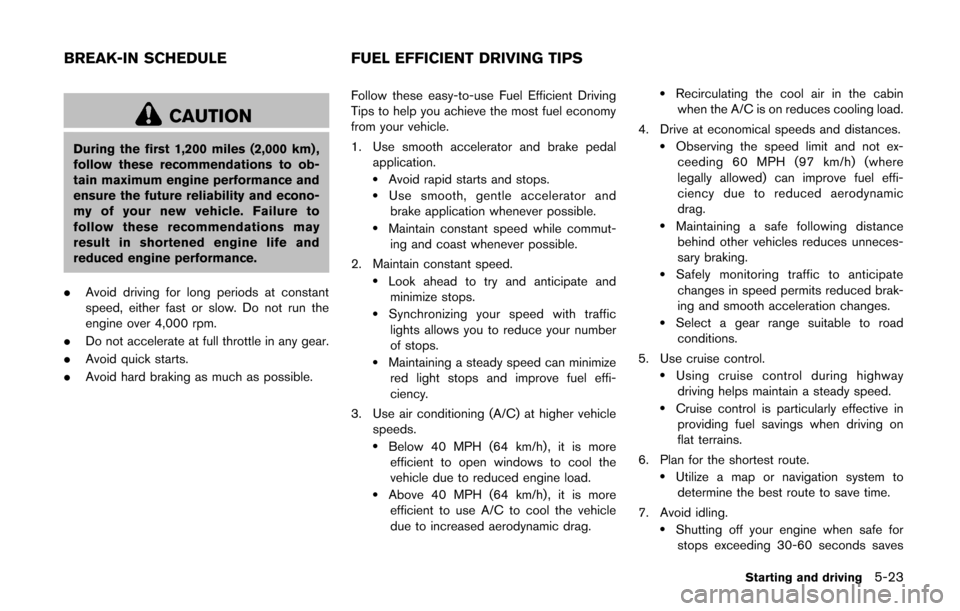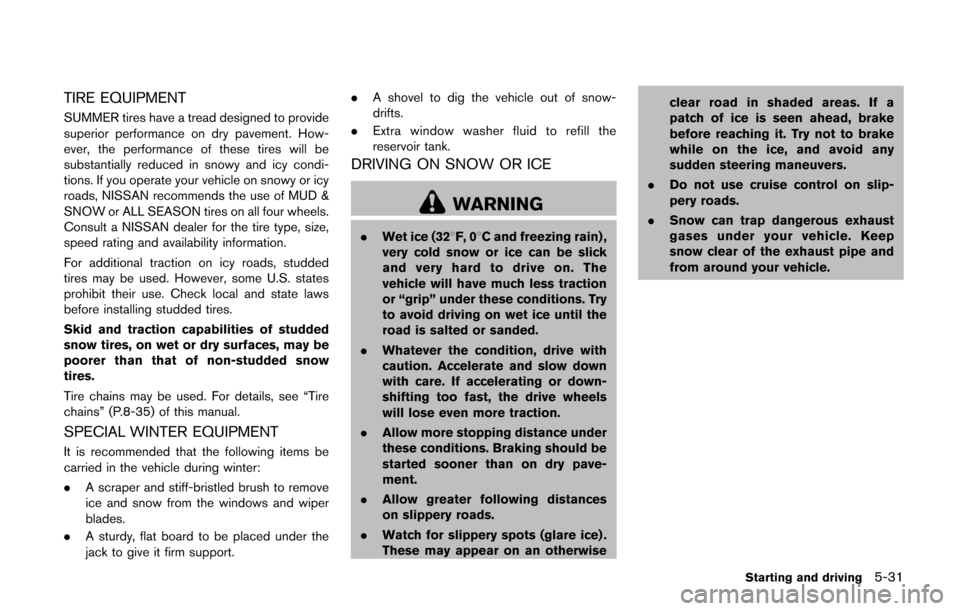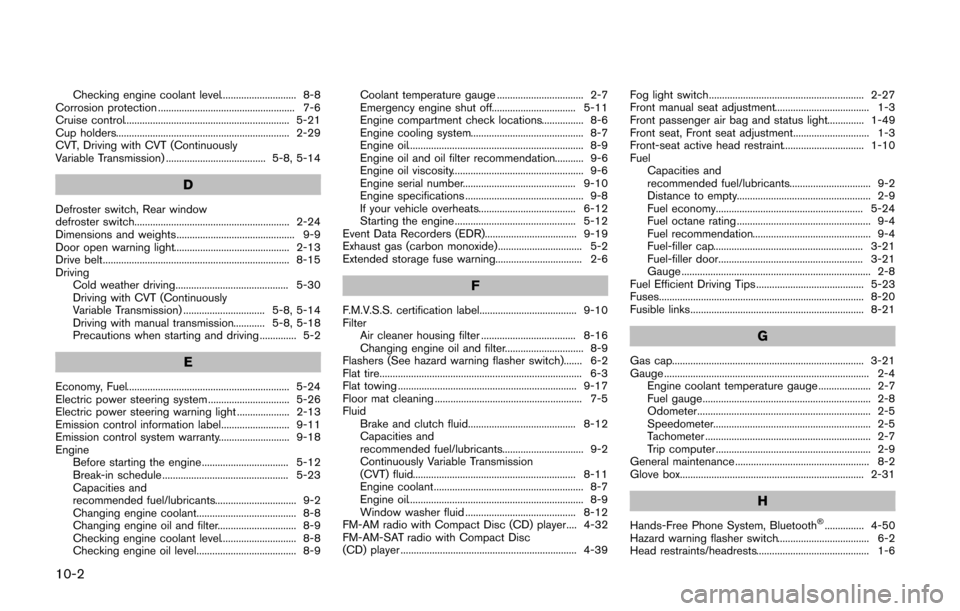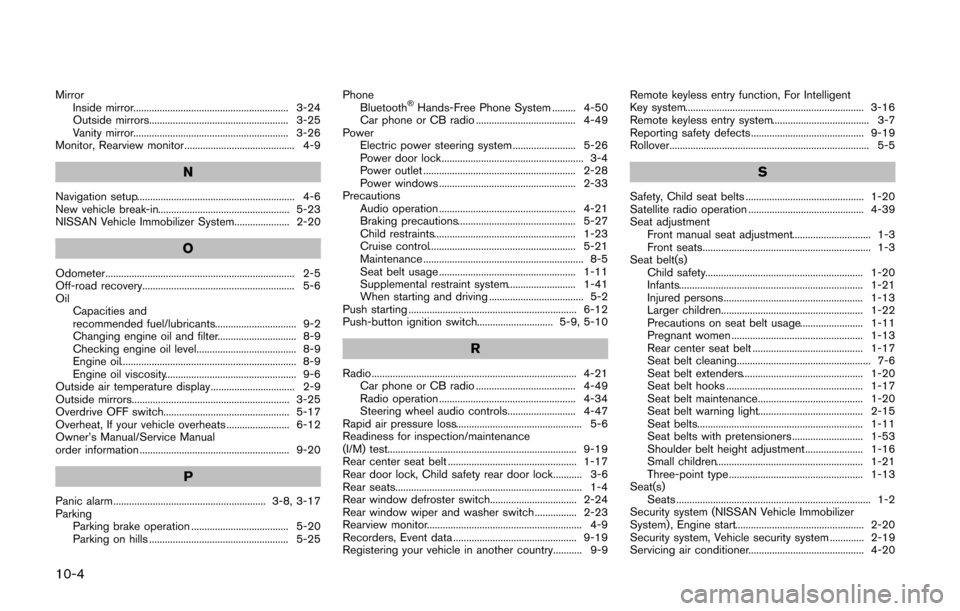2014 NISSAN CUBE cruise control
[x] Cancel search: cruise controlPage 228 of 332

CAUTION
During the first 1,200 miles (2,000 km) ,
follow these recommendations to ob-
tain maximum engine performance and
ensure the future reliability and econo-
my of your new vehicle. Failure to
follow these recommendations may
result in shortened engine life and
reduced engine performance.
. Avoid driving for long periods at constant
speed, either fast or slow. Do not run the
engine over 4,000 rpm.
. Do not accelerate at full throttle in any gear.
. Avoid quick starts.
. Avoid hard braking as much as possible. Follow these easy-to-use Fuel Efficient Driving
Tips to help you achieve the most fuel economy
from your vehicle.
1. Use smooth accelerator and brake pedal
application.
.Avoid rapid starts and stops..Use smooth, gentle accelerator andbrake application whenever possible.
.Maintain constant speed while commut-
ing and coast whenever possible.
2. Maintain constant speed.
.Look ahead to try and anticipate and minimize stops.
.Synchronizing your speed with traffic
lights allows you to reduce your number
of stops.
.Maintaining a steady speed can minimize red light stops and improve fuel effi-
ciency.
3. Use air conditioning (A/C) at higher vehicle speeds.
.Below 40 MPH (64 km/h), it is moreefficient to open windows to cool the
vehicle due to reduced engine load.
.Above 40 MPH (64 km/h) , it is moreefficient to use A/C to cool the vehicle
due to increased aerodynamic drag.
.Recirculating the cool air in the cabinwhen the A/C is on reduces cooling load.
4. Drive at economical speeds and distances.
.Observing the speed limit and not ex- ceeding 60 MPH (97 km/h) (where
legally allowed) can improve fuel effi-
ciency due to reduced aerodynamic
drag.
.Maintaining a safe following distancebehind other vehicles reduces unneces-
sary braking.
.Safely monitoring traffic to anticipatechanges in speed permits reduced brak-
ing and smooth acceleration changes.
.Select a gear range suitable to road conditions.
5. Use cruise control.
.Using cruise control during highway driving helps maintain a steady speed.
.Cruise control is particularly effective in providing fuel savings when driving on
flat terrains.
6. Plan for the shortest route.
.Utilize a map or navigation system to determine the best route to save time.
7. Avoid idling.
.Shutting off your engine when safe for stops exceeding 30-60 seconds saves
Starting and driving5-23
BREAK-IN SCHEDULE FUEL EFFICIENT DRIVING TIPS
Page 236 of 332

TIRE EQUIPMENT
SUMMER tires have a tread designed to provide
superior performance on dry pavement. How-
ever, the performance of these tires will be
substantially reduced in snowy and icy condi-
tions. If you operate your vehicle on snowy or icy
roads, NISSAN recommends the use of MUD &
SNOW or ALL SEASON tires on all four wheels.
Consult a NISSAN dealer for the tire type, size,
speed rating and availability information.
For additional traction on icy roads, studded
tires may be used. However, some U.S. states
prohibit their use. Check local and state laws
before installing studded tires.
Skid and traction capabilities of studded
snow tires, on wet or dry surfaces, may be
poorer than that of non-studded snow
tires.
Tire chains may be used. For details, see “Tire
chains” (P.8-35) of this manual.
SPECIAL WINTER EQUIPMENT
It is recommended that the following items be
carried in the vehicle during winter:
.A scraper and stiff-bristled brush to remove
ice and snow from the windows and wiper
blades.
. A sturdy, flat board to be placed under the
jack to give it firm support. .
A shovel to dig the vehicle out of snow-
drifts.
. Extra window washer fluid to refill the
reservoir tank.
DRIVING ON SNOW OR ICE
WARNING
.Wet ice (328F, 0 8C and freezing rain) ,
very cold snow or ice can be slick
and very hard to drive on. The
vehicle will have much less traction
or “grip” under these conditions. Try
to avoid driving on wet ice until the
road is salted or sanded.
. Whatever the condition, drive with
caution. Accelerate and slow down
with care. If accelerating or down-
shifting too fast, the drive wheels
will lose even more traction.
. Allow more stopping distance under
these conditions. Braking should be
started sooner than on dry pave-
ment.
. Allow greater following distances
on slippery roads.
. Watch for slippery spots (glare ice) .
These may appear on an otherwise clear road in shaded areas. If a
patch of ice is seen ahead, brake
before reaching it. Try not to brake
while on the ice, and avoid any
sudden steering maneuvers.
. Do not use cruise control on slip-
pery roads.
. Snow can trap dangerous exhaust
gases under your vehicle. Keep
snow clear of the exhaust pipe and
from around your vehicle.
Starting and driving5-31
Page 325 of 332

10-2
Checking engine coolant level............................. 8-8
Corrosion protection .................................................... 7-6
Cruise control............................................................... 5-21
Cup holders.................................................................. 2-29
CVT, Driving with CVT (Continuously
Variable Transmission) ...................................... 5-8, 5-14
D
Defroster switch, Rear window
defroster switch........................................................... 2-24
Dimensions and weights............................................. 9-9
Door open warning light............................................ 2-13
Drive belt....................................................................... 8-15
Driving Cold weather driving........................................... 5-30
Driving with CVT (Continuously
Variable Transmission) ............................... 5-8, 5-14
Driving with manual transmission............ 5-8, 5-18
Precautions when starting and driving .............. 5-2
E
Economy, Fuel.............................................................. 5-24
Electric power steering system ............................... 5-26
Electric power steering warning light .................... 2-13
Emission control information label.......................... 9-11
Emission control system warranty........................... 9-18
EngineBefore starting the engine................................. 5-12
Break-in schedule ................................................ 5-23
Capacities and
recommended fuel/lubricants............................... 9-2
Changing engine coolant...................................... 8-8
Changing engine oil and filter.............................. 8-9
Checking engine coolant level............................. 8-8
Checking engine oil level...................................... 8-9 Coolant temperature gauge ................................. 2-7
Emergency engine shut off................................ 5-11
Engine compartment check locations................ 8-6
Engine cooling system........................................... 8-7
Engine oil................................................................... 8-9
Engine oil and oil filter recommendation........... 9-6
Engine oil viscosity.................................................. 9-6
Engine serial number........................................... 9-10
Engine specifications ............................................. 9-8
If your vehicle overheats..................................... 6-12
Starting the engine .............................................. 5-12
Event Data Recorders (EDR)................................... 9-19
Exhaust gas (carbon monoxide)................................ 5-2
Extended storage fuse warning................................. 2-6
F
F.M.V.S.S. certification label..................................... 9-10
Filter Air cleaner housing filter .................................... 8-16
Changing engine oil and filter.............................. 8-9
Flashers (See hazard warning flasher switch)....... 6-2
Flat tire............................................................................. 6-3
Flat towing .................................................................... 9-17
Floor mat cleaning ........................................................ 7-5
Fluid Brake and clutch fluid......................................... 8-12
Capacities and
recommended fuel/lubricants............................... 9-2
Continuously Variable Transmission
(CVT) fluid.............................................................. 8-11
Engine coolant......................................................... 8-7
Engine oil................................................................... 8-9
Window washer fluid .......................................... 8-12
FM-AM radio with Compact Disc (CD) player.... 4-32
FM-AM-SAT radio with Compact Disc
(CD) player ................................................................... 4-39 Fog light switch........................................................... 2-27
Front manual seat adjustment.................................... 1-3
Front passenger air bag and status light.............. 1-49
Front seat, Front seat adjustment............................. 1-3
Front-seat active head restraint............................... 1-10
Fuel Capacities and
recommended fuel/lubricants............................... 9-2
Distance to empty................................................... 2-9
Fuel economy........................................................ 5-24
Fuel octane rating ................................................... 9-4
Fuel recommendation............................................. 9-4
Fuel-filler cap......................................................... 3-21
Fuel-filler door....................................................... 3-21
Gauge ........................................................................ 2-8
Fuel Efficient Driving Tips ......................................... 5-23
Fuses.............................................................................. 8-20
Fusible links.................................................................. 8-21
G
Gas cap......................................................................... 3-21
Gauge .............................................................................. 2-4 Engine coolant temperature gauge .................... 2-7
Fuel gauge................................................................ 2-8
Odometer.................................................................. 2-5
Speedometer............................................................ 2-5
Tachometer ............................................................... 2-7
Trip computer........................................................... 2-9
General maintenance ................................................... 8-2
Glove box...................................................................... 2-31
H
Hands-Free Phone System, Bluetooth®............... 4-50
Hazard warning flasher switch................................... 6-2
Head restraints/headrests........................................... 1-6
Page 327 of 332

10-4
MirrorInside mirror........................................................... 3-24
Outside mirrors..................................................... 3-25
Vanity mirror........................................................... 3-26
Monitor, Rearview monitor.......................................... 4-9
N
Navigation setup............................................................ 4-6
New vehicle break-in.................................................. 5-23
NISSAN Vehicle Immobilizer System..................... 2-20
O
Odometer........................................................................ 2-5
Off-road recovery.......................................................... 5-6
Oil Capacities and
recommended fuel/lubricants............................... 9-2
Changing engine oil and filter.............................. 8-9
Checking engine oil level...................................... 8-9
Engine oil................................................................... 8-9
Engine oil viscosity.................................................. 9-6
Outside air temperature display................................ 2-9
Outside mirrors............................................................ 3-25
Overdrive OFF switch................................................ 5-17
Overheat, If your vehicle overheats ........................ 6-12
Owner’s Manual/Service Manual
order information ......................................................... 9-20
P
Panic alarm.......................................................... 3-8, 3-17
Parking Parking brake operation ..................................... 5-20
Parking on hills ..................................................... 5-25 Phone
Bluetooth
®Hands-Free Phone System ......... 4-50
Car phone or CB radio ...................................... 4-49
Power Electric power steering system ........................ 5-26
Power door lock...................................................... 3-4
Power outlet .......................................................... 2-28
Power windows .................................................... 2-33
Precautions Audio operation .................................................... 4-21
Braking precautions............................................. 5-27
Child restraints...................................................... 1-23
Cruise control........................................................ 5-21
Maintenance ............................................................. 8-5
Seat belt usage .................................................... 1-11
Supplemental restraint system.......................... 1-41
When starting and driving .................................... 5-2
Push starting ................................................................ 6-12
Push-button ignition switch............................. 5-9, 5-10
R
Radio.............................................................................. 4-21 Car phone or CB radio ...................................... 4-49
Radio operation .................................................... 4-34
Steering wheel audio controls.......................... 4-47
Rapid air pressure loss................................................ 5-6
Readiness for inspection/maintenance
(I/M) test........................................................................ 9-19
Rear center seat belt ................................................. 1-17
Rear door lock, Child safety rear door lock........... 3-6
Rear seats....................................................................... 1-4
Rear window defroster switch................................. 2-24
Rear window wiper and washer switch ................ 2-23
Rearview monitor........................................................... 4-9
Recorders, Event data ............................................... 9-19
Registering your vehicle in another country........... 9-9 Remote keyless entry function, For Intelligent
Key system.................................................................... 3-16
Remote keyless entry system..................................... 3-7
Reporting safety defects........................................... 9-19
Rollover............................................................................ 5-5
S
Safety, Child seat belts ............................................. 1-20
Satellite radio operation ............................................ 4-39
Seat adjustment Front manual seat adjustment.............................. 1-3
Front seats................................................................ 1-3
Seat belt(s) Child safety............................................................ 1-20
Infants...................................................................... 1-21
Injured persons..................................................... 1-13
Larger children...................................................... 1-22
Precautions on seat belt usage........................ 1-11
Pregnant women .................................................. 1-13
Rear center seat belt .......................................... 1-17
Seat belt cleaning................................................... 7-6
Seat belt extenders.............................................. 1-20
Seat belt hooks .................................................... 1-17
Seat belt maintenance........................................ 1-20
Seat belt warning light........................................ 2-15
Seat belts............................................................... 1-11
Seat belts with pretensioners........................... 1-53
Shoulder belt height adjustment...................... 1-16
Small children........................................................ 1-21
Three-point type................................................... 1-13
Seat(s) Seats .......................................................................... 1-2
Security system (NISSAN Vehicle Immobilizer
System) , Engine start................................................. 2-20
Security system, Vehicle security system ............. 2-19
Servicing air conditioner............................................ 4-20